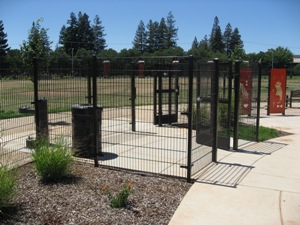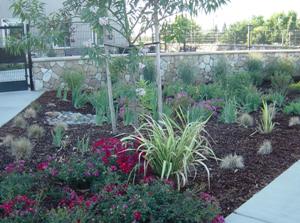Animal Housing Areas
 The facility provides a variety of animal housing areas from indoor/outdoor dog kennels to individual cat condos. Adoptable animals live in large habitat rooms with viewing windows. These habitat rooms showcase the animals in a relaxed setting, reducing their stress levels and increasing adoptions.
The facility provides a variety of animal housing areas from indoor/outdoor dog kennels to individual cat condos. Adoptable animals live in large habitat rooms with viewing windows. These habitat rooms showcase the animals in a relaxed setting, reducing their stress levels and increasing adoptions.
The facility also has several behavior evaluation rooms, where animals are quietly and calmly evaluated for proper adoption placement. These new animal housing areas and habitat rooms meet the guidelines for theAmerican Society of the Prevention of Cruelty to Animals' (ASPCA) Community Initiatives, a national grant program designed to improve U.S. regional adoption rates, of which the animal shelter is an area partner.
The facility is equipped with an advanced automatic cleaning system to ensure proper sanitation of animal holding areas.
The Adoption Gallery area contains 13 cat habitat rooms and 12 dog habitat rooms ranging in size from 5 feet up to 20 feet. Rooms have furniture for animals to relax on and explore while being visible at all times to facility visitors.
The new barn located at the back of the facility has eight stalls with outside corrals, a large pasture area and is equipped with hot water and lights.
The Public Dog Park - "The Bark Park"
We are the first municipal shelter in the nation to have a dog park on our grounds. Located at the front of the facility, the park totals two acres, with separate areas for large and small dogs, and is equipped with doggy drinking fountains. The park was constructed in partnership with grant money from the County Department of Regional Parks. The park celebrated its grand opening on April 24, 2010, and is open seven days a week, from 8 a.m. until dusk.
All dogs using the Bark Park must be current on their vaccinations, spayed or neutered, licensed and on their best behavior. Learn more about the Bark Park...
The County wants to provide a safe, free place for responsible dog owners to play with their dogs' off-leash. Sacramento County Code Title 8 references leash laws that state that dogs must be on a leash at all times unless they are in a designated area, and currently there are few dog parks in the region. By providing a dog park, we are encouraging dog owners to follow existing leash laws by providing a location they can allow their dogs off-leash to get plenty of exercise, and where they can meet and socialize with other dog owners.
For Staff and Volunteers
Volunteers are provided with their own work area and a public counter where they can provide assistance with adoptions and other valuable facility services. Learn how to get involved today!
The new facility includes a large, multi-purpose auditorium with audio/visual equipment and an outdoor patio area. This auditorium will be used for:
- Dog training classes
- Volunteer training
- Public meetings
- Public events and fundraisers
- Available for facility rental
There is a large loading dock with an enclosed area at the back of the facility where
animal control officers can unload animals in a private area to help reduce animal and officer stress. Once the animals arrive, they are entered into our computer system with a photo and additional information and will be posted on the shelter's website immediately.
Improvements in Efficiency and Operations
LEED certification - This is the first completed County building to be LEED certified. Several of the more prominent Title 24 requirements included in the shelter's design and construction are:
- Every room has a window that can be opened. Windows serve two purposes: 1) They let in natural light that reduces electricity uses and, 2) When opened, they let in fresh air for natural temperature control.
- All the landscaping was done with plants that grow slow and need little maintenance and water. The landscaping was done by the Regional Parks Department landscaping specialists.
- A retention pond is located behind the barn to control barn runoff.
- Special parking spots are available for low-emission vehicles. The parking lot was also designed with fewer parking spots to encourage the staff to carpool or use alternate transportation.
- Showers are available on premises to encourage staff to bike to work.
- Over 75 percent of waste material generated during construction was recycled.
- Approximately ten percent of the materials used contained recycled materials
- View more detailed information about the facility's LEED certification...

Rain Gardens: Green Alternative to Traditional Landscapes - Located at the front of the shelter, the Sacramento County Department of Water Resources designed and planted a rain garden that serves to collect rain water. Rain gardens are shallow, landscaped depressions that capture rain water from roofs and the pavement, and should ideally be located under the downspout of a property and at least 10 feet away from a building foundation. Rain Gardens are designed to keep rain water in the garden where it is needed and to absorb stormwater runoff, including loose dirt, fertilizers and pesticides from the roof and the lawn. Learn more about Rain Gardens and how to plant your own at https://www.beriverfriendly.net/.
